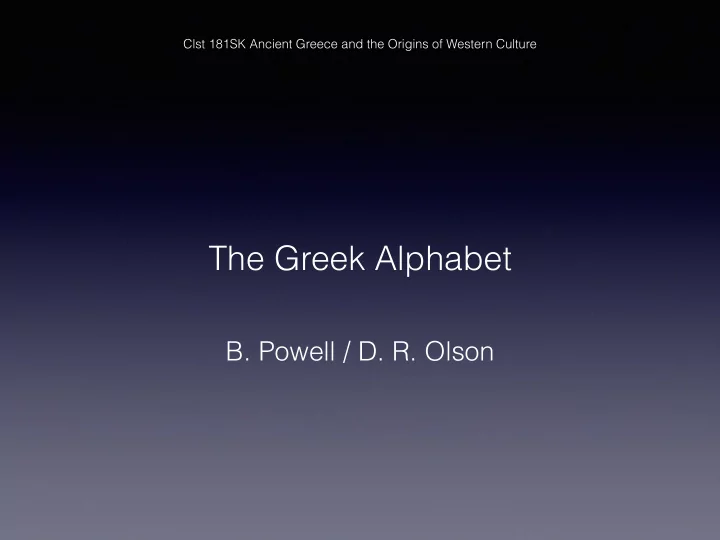

Clst 181SK Ancient Greece and the Origins of Western Culture The Greek Alphabet B. Powell / D. R. Olson
Monday: Oral Presentation Early Writing Systems in the East Cf. Olson, p. 79: “A logographic script such as Chinese, while cumbersome to Western eyes, is no longer thought of as primitive or limited as it was even two decades ago.”
Monday: Oral Presentation Two volunteers needed! Early Writing Systems in the East Cf. Olson, p. 79: “A logographic script such as Chinese, while cumbersome to Western eyes, is no longer thought of as primitive or limited as it was even two decades ago.”
Powell, chapter17: The Greek Alphabet: A Writing that Changed the World
Powell, chapter17: The Greek Alphabet: A Writing that Changed the World Core argument #1: “the adaptor’s achievement”
Powell, chapter17: The Greek Alphabet: A Writing that Changed the World Core argument #2: “the poetic inspiration”
Olson, chapter 4: What writing represents: A revisionist history of writing
Olson, chapter 4: What writing represents: A revisionist history of writing 1. Writing is not the representation of speech. Instead, it provides a conceptual model for that speech.
Olson, chapter 4: What writing represents: A revisionist history of writing 2. The history of scripts is not that of failed attempts and partial successes towards the invention of the alphabet. It is not, in short, evolutionary. Rather, the development of scripts is the by-product of attempt to use a script for a language to which it is ill-suited.
Olson, chapter 4: What writing represents: A revisionist history of writing 2. The history of scripts is not that of failed attempts and partial successes towards the invention of the alphabet. It is not, in short, evolutionary. Rather, the development of scripts is the by-product of attempt to use a script for a language to which it is ill-suited. Phoenician does not have contrasts in the basic word that involve vowels: KTB = katab, “he wrote,,” koteb, “writing”, katebu “they wrote” etc. � But Greek, like English, does: bed vs. bad for instance
Olson, chapter 4: What writing represents: A revisionist history of writing 3. Scripts provide models for understanding language, that is, they assist in helping us think about the nature of language. In that sense, “writing is in principle metalinguistics.”
Olson, chapter 4: What writing represents: A revisionist history of writing 1. Writing is not the representation of speech. Instead, it provides a conceptual model for that speech. 2. The history of scripts is not that of failed attempts and partial successes towards the invention of the alphabet. It is not, in short, evolutionary. Rather, the development of scripts is the by-product of attempt to use a script for a language to which it is ill-suited. 3. Scripts provide models for understanding language, that is, they assist in helping us think about the nature of language. In that sense, “writing is in principle metalinguistics.”
Key Terms and Ideas � -Cuneiform & its progression from Sumerian to Akkadian -Linear A -Linear B (=Mycenaean) -Logographic scripts -Syllabary: system of writing in which symbols/signs stand for syllables -Cuneiform: in what sense “logosyllabic”? -Western Semitic proto-alphabets (Phoenician, for example): in what essential ways these differ from the Greek alphabet -Alphabet: graphic system whose signs come in a certain order and represent phonemes - in what respect do the Semitic scripts not agree with this definition? -Phoneme: a sound that makes a difference in meaning; “pieces of sound” that make up all possible combinations of human speech. “The smallest contrastive linguistic unit which may bring about a change of meaning” Give an example -Speech as a continuous wave: why is this important for understanding the nature of writing systems? -Brahmi script - what is it and why is it (potentially) important? � � Brief Essay � -Be prepared to discuss the differences between Powell and Olson on how the alphabet came to be -Be prepared to describe and discuss in some detail Olson’s notion that writing systems serve as “models for speech” -Be prepared to describe with examples the “evolution” of writing systems from emblem to logographic (addition of syntax) to syllabic (or logosyllabic) to proto-alphabet to alphabet
Recommend
More recommend